Sanofi Aventis Korea is aiming to revolutionize the treatment landscape for Pompe disease patients with the reimbursement of its novel enzyme replacement therapy, Nexviazyme (ingredient: avalglucosidase alfa-ngpt), from Sep. 1, the company said.

Sanofi-Aventis Korea organized a press conference at the Grand InterContinental Seoul Parnas in southern Seoul on Monday to commemorate the reimbursement of Nexviazyme for treating Pompe disease .
Nexviazyme is recognized as an incrementally modified biopharmaceutical, gaining approval for its pharmacological enhancements over Sanofi's initial Pompe disease treatment, Myozyme.
Nexviazyme differentiates itself by modifying the sugar structure of Myozyme, thus enhancing the cellular absorption of its primary component. It received approval from the Ministry of Food and Drug Safety in March.
Pompe disease is a rare genetic disorder caused by a deficiency in the GAA enzyme (acid a-glucosidase), which is responsible for breaking down glycogen within lysosomes. This enzyme deficiency results in the excessive accumulation of glycogen in various cells, predominantly in muscle cells, leading to irreversible muscle damage.
Pompe disease is divided into two categories -- infantile-onset Pompe disease (IOPD) and late-onset Pompe disease (LOPD).
IOPD manifests within the first year of life and is characterized by severe cardiac-related conditions and rapid, life-threatening muscle deterioration. Without treatment, the condition can lead to serious respiratory problems and potential death within a year.
LOPD, on the other hand, might only show symptoms much later, even into the 60s. Due to its slower progression, diagnosis can take several years, with patients experiencing worsening muscle strength, sleep disorders, and respiratory issues, ultimately diminishing the quality of life and life expectancy.
According to studies from Taiwan and Germany, the prevalence of IOPD ranges from 1 in 35,000 to 1 in 138,000, while LOPD occurs in approximately 1 in 57,000 individuals.
At the press conference, Professors Shin Jae-Young from Hallym University Dongtan Sacred Heart Hospital and Lee Beom-Hee from Asan Medical Center illuminated the clinical significance of Nexviazyme in treating LOPD and IOPD.
Professor Shin emphasized the necessity of early diagnosis and treatment for LOPD, while also highlighting Nexviazyme's ability to enhance cellular penetration of the therapeutic enzyme by 15 times compared to existing treatments.
"This enhanced absorption showed significant clinical improvements in respiratory function, mobility, muscle strength, and quality of life in the phase 3 COMET trial," Shin said.
Professor Lee underscored the life-saving potential of early treatments in IOPD patients and the promising clinical effects of Nexviazyme, which could change the therapeutic paradigm for IOPD.
"IOPD is a devastating condition that can kill within a year, but with early treatment, a normal life is possible," Lee said. "Clinical trials have shown that enzyme replacement therapy prolongs survival, reduces cardiac dysfunction, and improves myocardial and skeletal muscle function, and some patients with IOPD can walk, suggesting that Nexviazyme, with its improved clinical outcomes over existing therapies, could be a paradigm shift in the treatment of IOPD."
Sanofi-Aventis Korea also expressed strong optimism about Nexviazyme's transformative potential in treating Pompe disease.
"Nexviazyme maximized cellular penetration of the therapeutic enzyme," said Cho In-su, Director of Medical Affairs at Sanofi-Aventis Korea. "This simple structural change resulted in clinically effective cellular penetration, as well as more favorable immunogenic and neutralizing antibody responses."

